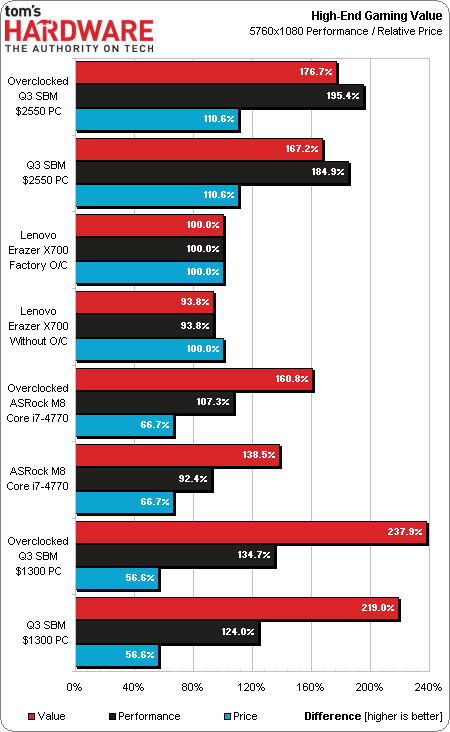Lenovo Erazer X700 Gaming PC Review: Is It As Fast As It Looks?
Famed for its ThinkPads, data center-oriented servers, and dependable office PCs, Lenovo is looking to carve out a piece of the enthusiast segment with its Erazer X700 gaming system. Can this sexy-looking setup stand up against our SBM configurations?
But Is The Erazer X700 A Gamer?
The overall value rating on the previous page is really only important if you're looking for a multifunction performance-oriented PC. Lenovo is marketing its Erazer X700 as a more gamer-oriented box, though. When we get that specific, its high-end six-core CPU is an extravagance. But is that value-oriented, still-fairly-high-end graphics card a limitation?
Though AMD’s Radeon HD 8950 is a good card for most single-screen resolutions, it’s not exactly a powerhouse in Eyefinity. And though a few failed runs might not impact the majority of gamers, a $2300 system isn’t designed for the majority of gamers; it's intended for the top tier of folks who know what balance means, and that when you pair an almost $600 CPU with a $250 graphics card, frame rates are going to suffer. That this system fell behind our $1300 System Builder Marathon PC at the same quality settings means that gaming isn't really what the Erazer is best at.
The truth about Lenovo’s Erazer X700 is that it’s a home workstation that games well, rather than a purpose-built gaming powerhouse able to handle professional tasks during the workday. Huge storage capacity, Blu-ray burning flexibility, and a workstation-class CPU would have made this the perfect excuse for me not to visit the computer lab back in my university days, and I believe that a large number of today’s power users will find the Erazer X700 similarly suits their needs.
If we were to give Lenovo one piece of advice to wrap things up, it'd be to put a bigger emphasis on graphics performance, and perhaps dial back the CPU to save some money. Those six x86 cores, overclocked, don't further the X700's gaming mission, while a second Radeon HD 8950 in CrossFire would have really bolstered our gaming benchmarks.
Get Tom's Hardware's best news and in-depth reviews, straight to your inbox.
Current page: But Is The Erazer X700 A Gamer?
Prev Page Performance Per Dollar-
larsoncc I won the $2550 computer featured in the Q3 SBM Marathon. I believe their scores using that system were 'slightly' hampered by fact that one of the 760s that was going bad. After RMA'ing the card, and using the same overclocks as featured in the SBM article, as well as moving the system to a high airflow case (Corsair Carbide Air 540) the 3DMark score is 19,100 (http://www.3dmark.com/3dm11/7455484). Thanks Tom's!Reply -
chumly wtf resolutions are you testing? How about 1440p? Hardly ANYONE uses dual/triple monitor setups because the framerate sucks so entirely and 99% of the people on the planet don't have $5k to throw at a gaming PC. you are wasting your time. give us SINGLE monitor configs, for the love of god.Reply -
dudewitbow Reply12040927 said:....and wth is an HD 8950?!?!?!
HD 8XXX cards are rebranded 7XXX cards for OEMS to use for marketing, cause you know, uninformed Consumers love to think that larger number means better and that new products(despite not really being new) convinces them to buy it. an 8950 should be a rebranded 7950 -
SWEETMUSK the case is looking cool but,why they set the power at top?the power can't be hot it should set under the case and video card is not goodReply -
m32 They could've put a R9 280x in it, but this isn't meant for the guys on this site. This is meant for sucke...... cough..... the average consumer.Reply

